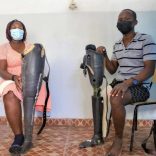Mozambique: Japan to support rehabilitation of Fisheries School Workshop in Matola and construction ...
Mozambique reports rise in prevalence of hypertension

File photo
The chairman of the Mozambican Heart Association (AMOCOR), Albertino Damasceno, has reported a rise in the prevalence of arterial hypertension in Mozambique, from 33 percent in 2005 to 39 percent in 2014-15, APA can report on Tuesday.Damasceno addressed a media briefing in Maputo on Tuesday, and presented the activities to be carried out throughout the country, whose high point will be on World Arterial Hypertension Day, commemorated on 17th of May.
Damasceno said data from national surveys carried out by the Ministry of Health (MISAU) reveals that apart from the increased prevalence, only 16 percent of those affected by arterial hypertension know their condition.
He added that the epidemiological picture is extremely serious across the African continent, where the prevalence is the highest, “yet less known, less treated and less controlled”.
“Hypertension is a disease that has a silent characteristic, it does not hurt and the patient feels absolutely nothing until the day that is surprised by a thrombosis,” he said.
High blood pressure, according to the official, is a result of a rise in blood pressure that may lead to the occurrence of stroke in patients.
The change in the pattern of the disease is, according to Damascene, related to rural-urban migration, “adopted by many who previously lived in a quiet and unfriendly environment in the countryside, where they work and walk frequently, consuming foods taken from the farm and unprocessed , Without the ‘stress’ that happens in the cities.”
For example, he went on, there are two types of stroke. The first is that an artery responsible for transporting blood to a part of the brain is ruptured and causes hemorrhage (hemorrhagic stroke), which has strong links with arterial hypertension.
However, there is also ischemic stroke, where the artery blocks and suddenly stops pumping the blood into a given part of the brain.
In the 2006/7 study, it was found that 40 per cent of the strokes occurring in the city of Maputo are hemorrhagic, and this worried authorities that they are occurring in younger individuals, in addition to their high mortality rate, when compared to the resulting index of the ischemic ones. The hemorrhagic stroke mortality rate may be greater than 50 percent.
In order to reverse the trend, AMOCOR in partnership with the provincial health directorates will carry out various activities aimed at raising awareness of society, and increasing knowledge about the disease that is still very low, in order to reduce the high risk of thrombosis and heart attack.
“We are going to do activities in workplaces, like banks and companies where we are going to measure blood pressure,” Damasceno announced, pointing to places of public concentration such as houses of worship (churches and mosques) at weekends, an example that will be replicated, particularly in markets and supermarkets.













Leave a Reply
Be the First to Comment!
You must be logged in to post a comment.
You must be logged in to post a comment.